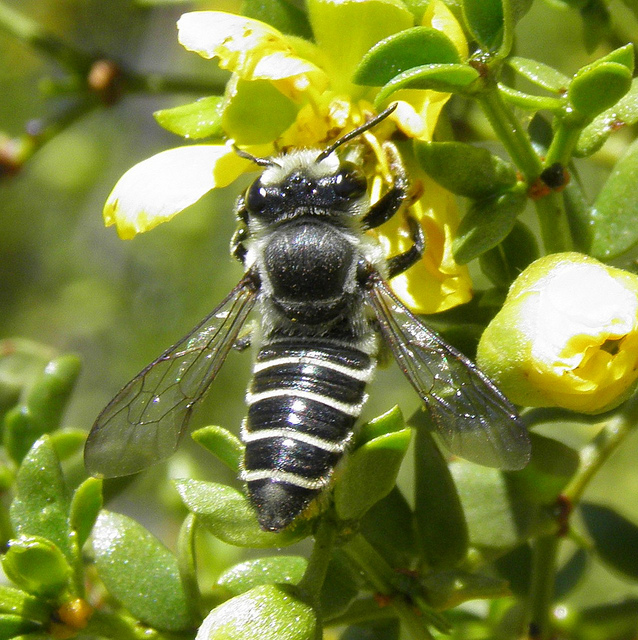Yesterday at the Javelina exhibit of the Arizona Desert Museum we watched an amazing spectacle: There was a wooden fence post with old wood-boring beetle holes. A swarm of hundreds of bees was hovering, and individuals seemed to be entering one of the holes. You really have to watch the video to get an impression of how many bees were buzzing around that hole in their frenzied attempts to enter.
Human visitors trying to get a better view of a group of javelinas resting in the shade of a bridge were leaning close to the post, oblivious of the bees. The bees, in turn, ignored the people completely. Weird!
One clue to the solution was the size of the bees - about 1/3 smaller than Honey Bees. They were also quite gray compared to the more rusty, golden Apis mellifica.
They looked very much like Leafcutter Bees, Megachilinae, to me. Except, those are solitary and shouldn't appear in swarms? ( Most of the over 20 000 globally-known bee species are solitary. A single mated female builds and provisions a nest, lays one egg per brood cell. Usually there are several brood cells to a nest, and sometimes there are guests, but that is another story). Megachilinae females do sometimes share the entrance to a nest, but inside they take care only of their own.
Back to my 'bee swarm'. My first pictures, rather than direct observation, showed that all the entrance-seeking bees had long antennae which indicated males. Close observation also revealed that only very few were actually getting into the entrance, but there seemed to be at least one bee facing out, blocking the hole.
 |
| A male bee from the 'swarm' of suitors, Identified by J. Asher as Megachile subgenus Chelostomoides |
So my interpretation of the phenomenon is this:
These were indeed solitary bees, but the number of occupied, mostly still sealed holes, indicates communal nesting. This occurs because the bees requirements for nesting sites are very specific and good sites are rare. So this log with probably optimal hole size, sun exposure, humidity, food source vicinity, and nesting material availability had attracted scores of female bees to build their individual nests and lay their eggs.
(From Gordon's Solitary Bee Page: The largest recorded aggregation is 423,000 female bees in an area of 1300 m2. Aggregations can continue of over 20 years or can become extinct.)
Most solitary bees are protandrial. This means that males hatch before females (in fact in serial nests with rows of brood cells, their cells are the ones closest to the entrance) So the males hatch - and wait around the nesting site for the females to emerge, often days later. Released pheromones will keep them informed of the progress inside.
Here is another video that I posted to flickr where the quality is better.
Yesterday at the ASDM Javelina exhibit, many males hatched from the aggregation (but not hive or colony) of nesting sites. Other males may have joined in. They were hanging around, waiting, until the emergence of females from at least one hole began. At that moment, female pheromones whipped the whole waiting gang into a frenzy, resulting in literally hundreds of males hovering in front of that one hole hoping to get lucky. The very short life span of the males probably gives them a 'now-or-never' chance at procreation.
 |
| Megachile females collect pollen on the underside of their abdomen. |
She has to collect pollen which she transports in a thick layer under her belly (honey bees carry it on their hind legs) as provision, lay one egg per chamber with the predetermined males towards the entrance, and seal the nest to give the brood a protected place for its development.
She will not return to actually care for the larvae like the social honey bees do.

Hiç yorum yok:
Yorum Gönder